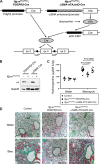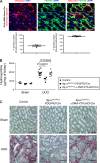α-Smooth muscle actin is an inconsistent marker of fibroblasts responsible for force-dependent TGFβ activation or collagen production across multiple models of organ fibrosis
- PMID: 26944089
- PMCID: PMC4867351
- DOI: 10.1152/ajplung.00350.2015
α-Smooth muscle actin is an inconsistent marker of fibroblasts responsible for force-dependent TGFβ activation or collagen production across multiple models of organ fibrosis
Abstract
Fibrosis is a common pathological sequela of tissue injury or inflammation, and is a major cause of organ failure. Subsets of fibroblasts contribute to tissue fibrosis in multiple ways, including generating contractile force to activate integrin-bound, latent TGFβ and secreting excess amounts of collagens and other extracellular matrix proteins (ECM) that make up pathologic scar. However, the precise fibroblast subsets that drive fibrosis have been poorly understood. In the absence of well-characterized markers, α-smooth muscle actin (αSMA) is often used to identify pathologic fibroblasts, and some authors have equated αSMA(+) cells with contractile myofibroblasts and proposed that these cells are the major source of ECM. Here, we investigated how well αSMA expression describes fibroblast subsets responsible for TGFβ activation and collagen production in three commonly used models of organ fibrosis that we previously reported could be inhibited by loss of αv integrins on all fibroblasts (using PDGFRβ-Cre). Interestingly, αSMA-directed deletion of αv integrins protected mice from CCl4-induced hepatic fibrosis, but not bleomycin-induced pulmonary or unilateral ureteral obstruction-induced renal fibrosis. Using Col-EGFP/αSMA-RFP dual reporter mice, we found that only a minority of collagen-producing cells coexpress αSMA in the fibrotic lung and kidney. Notably, Col-EGFP(+)αSMA-RFP(-) cells isolated from the fibrotic lung and kidney were equally capable of activating TGFβ as were Col-EGFP(+)αSMA-RFP(+) cells from the same organ, and this TGFβ activation was blocked by a TGFβ-blocking antibody and an inhibitor of nonmuscle myosin, respectively. Taken together, our results suggest that αSMA is an inconsistent marker of contractile and collagen-producing fibroblasts in murine experimental models of organ fibrosis.
Keywords: fibrosis; integrin; αSMA.
Copyright © 2016 the American Physiological Society.
Figures









References
-
- Abe M, Harpel JG, Metz CN, Nunes I, Loskutoff DJ, Rifkin DB. An assay for transforming growth factor-beta using cells transfected with a plasminogen activator inhibitor-1 promoter-luciferase construct. Anal Biochem 216: 276–284, 1994. - PubMed
-
- Adler KB, Low RB, Leslie KO, Mitchell J, Evans JN. Contractile cells in normal and fibrotic lung. Lab Invest 60: 473–485, 1989. - PubMed
-
- Annes JP, Rifkin DB, Munger JS. The integrin alphaVbeta6 binds and activates latent TGFbeta3. FEBS Lett 511: 65–68, 2002. - PubMed
Publication types
MeSH terms
Substances
Grants and funding
LinkOut - more resources
Full Text Sources
Other Literature Sources
Molecular Biology Databases

